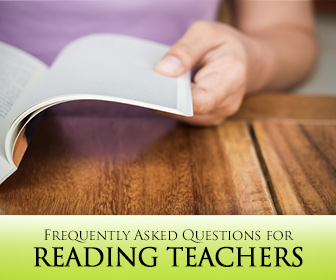Top 4 Tools Your Students Need to Really Understand What They Read


I was filled with questions on how to apply the instructional methods I had studied, and I found that my fellow teachers were my best resource in getting me through that first year. Later, with teaching experience came a new role. Now I was answering questions for each year’s new crop of teachers. Here are some of the questions I asked and answered over the years, and you might have too, about teaching reading.

We start reading out loud very early in our own academic careers. As early as kindergarten we take turns with our classmates reading one paragraph or one sentence at a time from our text books and handouts. Learning a second language, however, doesn’t demand the read aloud skill. In fact, reading out loud says more about a student’s pronunciation skills than it does their reading skills. When students read aloud skillfully, it is easy to mistake their good pronunciation and fluency for comprehension, which actually has very little to do with whether a person can read out loud. In addition, if you think about the practical applications of English in your students’ futures, very rarely will they ever have to read out loud. For these reasons, I do not have my reading students take class time to practice the skill of reading aloud. My preference is that students read longer passages at home and that class time is for communicative and comprehension activities. When students do need to read in class, I have them read silently and use more effective methods to check their comprehension. That’s not to say we never read out loud; it’s just not something I make a point of spending class time on.
Communicative classrooms are those that focus on language use – primarily verbal. When you are teaching students how to read long (or short) passages from a text book, communicative activities are not as instinctual as they may be in, say, a speaking class. Still, reading can be communicative. Discussions are an easy way to incorporate verbal language use into a reading class. Have groups of students make predictions about a reading selection based on pictures and headings. Do post reading discussions to see if students can reiterate the points in an article or retell the events in a piece of fiction. Jigsaws are also great for encouraging communication between students. Have three students read different sections of an article (one to two paragraphs is usually enough) and then have them explain their sections to students who did not read them. If you break your article into three parts, put three students together to discuss the article. One student should have read each part. They can then tell each other what they read and piece together the overall content of the article.
With a little creativity, you can check reading comprehension in lots of fun and communicative ways. Try sequencing events of a story. Have students retell the major events of a fictional piece in comic strip style. Have students write about characters in their reading piece or write a letter to that character. Have students act out what they read or draw diagrams of a place or item discussed in the reading selection. Have students write their own comprehension questions with multiple choice or true/false answers; then have the class answer all of the questions. For more details on how to check reading comprehension, see Already Read It, But Did They Get It: 10 Ways to Check Reading Comprehension.
Nearly every ESL teacher, no matter what class they are teaching, will be a teacher of vocabulary. Without vocabulary, one cannot know, understand or use a language. But for reading teachers, vocabulary instruction should be secondary. At every level, reading passages will contain words that are unfamiliar to your students. I have found that teaching vocabulary on an as needed basis works best in my reading classes. I challenge students to guess the meaning of unfamiliar words in a passage before using an English only dictionary to find the definition. If your students make notes on the meanings of certain words in a reading passage, make sure they are on a separate piece of paper. This will encourage students to remember what the word means and not rely on their notes or translation for comprehension.
The more you can include realia in your classroom, the more practical your instruction will be. Think about the goal of your students. Will they pursue academics in English? Will they use English in their place of business? Are they studying for some other reason? Once you have pinpointed why they are learning English, think about the types of materials they will need to read in that environment. Academic students will need to read text books and take exams. Business persons will have to write letters and emails. Use these materials whenever you can. You will have to teach different strategies for reading – reading a text book with headings and subject specific vocabulary is different from reading a business proposal. Teach your students how to read the materials they will encounter after your class and they will have a strong skill set for real life reading when they complete their ESL programs.
If you are teaching English as a second language in the U.S. or other English speaking country, reading sources are all around you. You can use almost anything to teach your students practical reading skills. I have used common items like cereal boxes and ice cream containers and others that were not so common like movie schedules, weather maps, greeting cards and transcripts from chat rooms. If you are looking for interesting reads for your students, pay close attention for a day or two of all the things you read. You will probably find that you read far more than you realize: traffic signs and instructions, product manuals, television programming guides, magazines, cooking instructions and many others. Make a list of all these things you read, and then think about which ones will tie into your curriculum. For example, I had my students read an ice-cream container before reading an article on the Ben and Jerry’s corporation. (Of course, we shared the pint, too.) If you are teaching overseas, you might find good and creative reading material a bit more difficult to find, but still take note of what you read. You can find many English materials online even if you can’t bring the original source to class.
Whether you are new to teaching reading or are answering questions of your coworkers, I hope you find these answers helpful.